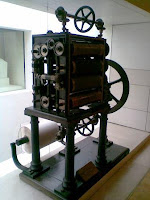Having spent many hours of the past year wandering around the Museum of Scotland, looking for objects to inspire me, it is often more than one piece that affects my choice of 62 words. In this case, the influence goes back much further, to the introduction of Big Issue vendors. At the time, I (perhaps unfairly) thought of them as the realization of the ‘Licensed Beggars’ that Ian McEwan depicted in his novel, The Child in Time.
 Of course, licensed begging goes back many years. In the late 18th/early 19th Centuries, the Church was responsible for social provision, and could control who was permitted to beg in its parish. It could also commend its citizens, who wished to move on to another parish, on their upstanding character and good behaviour. While my starting-point for this sestude was a poor-badge from Leith, I was also influenced by the sign in Lady Stairs Close, and a hand-written testimonial for one William Mathers.
Of course, licensed begging goes back many years. In the late 18th/early 19th Centuries, the Church was responsible for social provision, and could control who was permitted to beg in its parish. It could also commend its citizens, who wished to move on to another parish, on their upstanding character and good behaviour. While my starting-point for this sestude was a poor-badge from Leith, I was also influenced by the sign in Lady Stairs Close, and a hand-written testimonial for one William Mathers.
As we approach the season of good will, I thought I would turn this concept on its head. In an ideal world, poverty and charity could be abolished or at least, reduced, if people lived according to their need instead of their greed. On the top floor of the Museum, there is a short clip of Margaret Thatcher giving her diabolical ‘Sermon on the Mound’ Address to the General Assembly of the Church of Scotland.
According to Thatcher, ‘abundance rather than poverty has a legitimacy that derives from Creation.’
This is a shocking and heretical re-reading of Biblical truth: St Paul (in his letter to the Thessalonians) speaks of Adam being told to labour for sufficiency. This is the Biblical alternative to poverty, not abundance. Thatcher was not only dabbling in theology well beyond her ken; she was also being highly offensive towards the marginalized, disenfranchised and under-privileged whose ‘poverty’ stems from inequality, not laziness.
I do not believe in God as such, but I certainly think that Christianity is based on unconditional love for all. My ‘God’ is a God of equality.
This means that, while for some people, ‘living off the state’ becomes a way of life (and believe me, life on benefits is as insufficient as the minimum wage is as a ‘living wage’) we cannot allow the Government to realistically cut – and we’re talking, systematically abolish in the long run – the Welfare System on the basis of a small percentage of so-called ‘shirkers and scroungers.’ The real spongers are those for whom beggar-my-neighbour – profit-making at the expense of others – is a way of life. The Tax-evading coffee-shops, the Corporate Businesses, the Private Landlords, the CEOs of profiteering retailers who pay their workers peanuts, and (at risk of offending some folk) the Royal Family.
How we can allow American Tycoons to run roughshod over our green and pleasant (Scot)land while the Government strips away the social-contract that Beverage provided us in 1942 is simply beyond me. It beggars belief that the £26bn owed in unpaid corporate tax could pay for the Health Service outright. Margaret Thatcher once, when asked (by John Simpson) to sum up Christianity in a word, said: “Choice.” Well I’m sorry, Maggie (and her pathetic successors): beggars can’t be choosers.
And having got that off my chest, here is my 24th sestude. (a 62-word piece, based on a museum artefact)
 I’d like to end by thanking ALL the staff and volunteers at the Museum for the job they do. It is a National Treasure, of which we all, whatever our background, politics or perceived nationality, should be proud – and visit as often as possible.
I’d like to end by thanking ALL the staff and volunteers at the Museum for the job they do. It is a National Treasure, of which we all, whatever our background, politics or perceived nationality, should be proud – and visit as often as possible.






.jpg)









.jpg)





